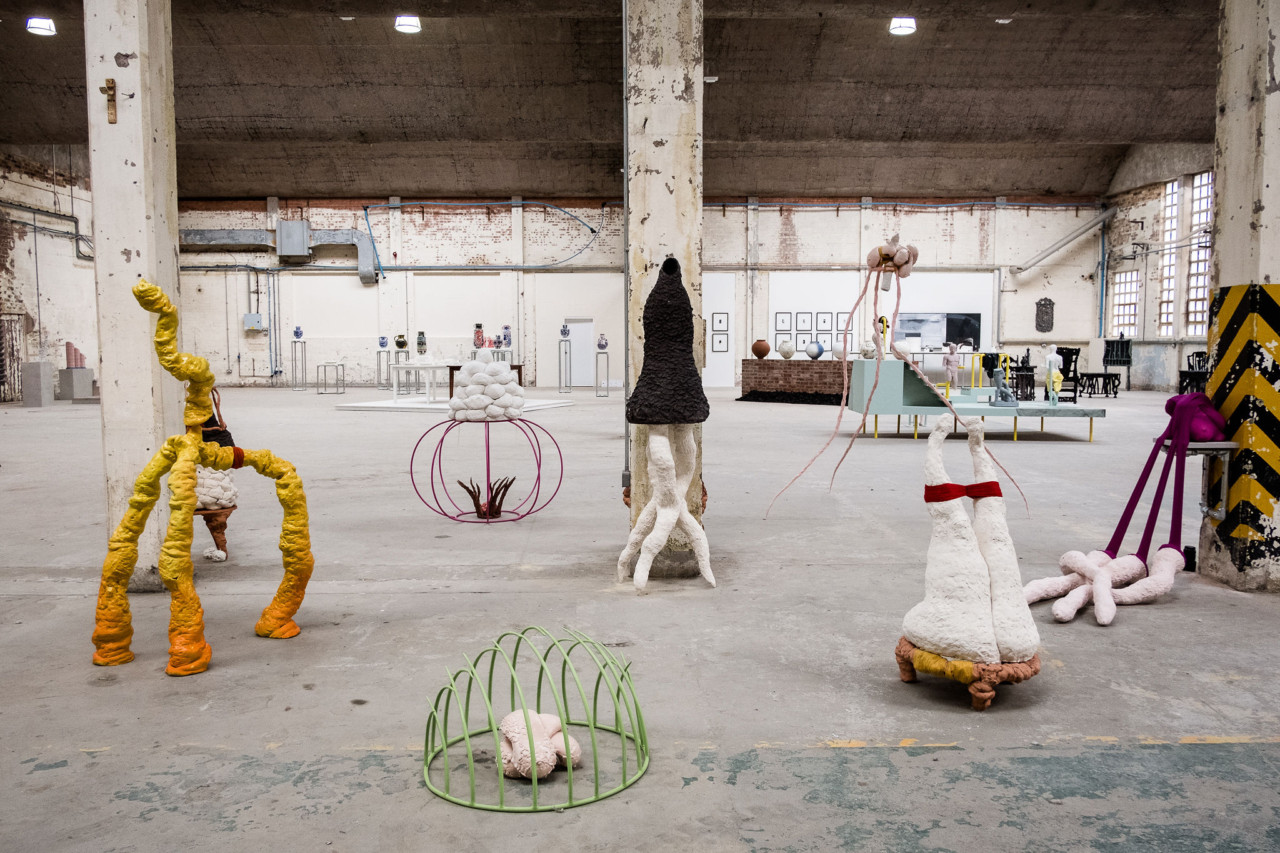


British Ceramics Biennial 2019 in the China Hall of the original Spode factory, Stoke-on-Trent, photo Jenny Harper
All around you, as you walk towards the China Hall at the centre of the Spode Factory site, rise workmanlike two-storey, red brick buildings, their dark windows filmed with cataracts of grime. Inside, dreaming under accumulating dust and cobwebs, are stacked the thousands of plaster molds that were the foundation of an industry that is almost 250 years old. In shafts of cool autumn light, the pale negatives of cups and bowls, chargers and ewers, pots, jars, candelabra, plates, tower over your head, stacked to the rafters on creaking shelving.
Production has largely ceased in Stoke-on-Trent. There is a melancholic atmosphere that unavoidably calls to mind Mike Nelson’s extraordinary The Asset Strippers that has just closed in Tate Britain’s Duveen Galleries. It is about the passing of a culture of making, the loss of hand skills that shaped lives as well as artefacts. In the little museum on site, there is a film that follows a single artisan, making a press-moulded oval plate.The pleasure of watching this lies in the practiced, confident exercise of a hundred sequenced actions, the tools all just to hand, designed for single and particular tasks.
Neil Brownsword, artist and Professor of Ceramics at Staffordshire University, was born in Stoke and is perhaps the greatest advocate for, and historian of, the ceramics industries that were emblematic of the six towns that made up the city. He has initiated a project to record the historic plaster molds here through 3D scanning. Brownsword’s large scale installation Externalising the Archive sits outside, across the rails that would once have carried trucks full of pots to the kilns. An array of plaster molds is stacked against the back wall, while in the foreground, on six long low panels, sit new bone china castings from some of these historic molds. They are partial, fragmentary, unfinished objects and there is something almost forensic about the way they are arranged. A reading of entrails. On the wall behind, silicon castings drape in equally visceral style.
The Ceramics Biennial is in its tenth year and the cavernous China Hall is the principal venue, bringing together a huge range of work from masters to recent graduates, British-based and from an impressive number of international centres. The winner of the 2017 student award, Eusebio Sanchez, returns to show a new body of work made at the Ceramic Research Centre at Guldagergaard in Denmark. Sanchez makes the ancient hand-building coil method, that is often hidden in finished pots, the principal feature of his sculptures. He compares the process of building form through coiling with Paul Klee’s intuitive abstract drawing technique – taking a line for a walk. The finished works combine biomorphic and geometrical form, stoneware glaze and engobe, a coloured clay slip that gives his sculptures a distinctive candy coloured appearance.
Another international visitor to pick out is Shirley Bhatnagar, one of three international ceramicists who spent several months in Stoke on a residency – Bhatnagar was supported by the Charles Wallace India Trust. Her lively group of small-scale works pick up the formal traditions of Toby Jugs and Staffordshire flatback ware – exploring the colonial links between Britain and India through the characters of William Dalrymple’s 2002 novel White Mughals.
Eunjung Suh is one of the recent graduates featured in the Fresh section of the Biennial. A graduate of the Korea National University of Art and most recently the RCA in London, Suh’s bestiary of fantastic creatures leer and grimace like characters from an animé nightmare.
The Award section of the Biennial showcases ten artists selected by a specialist panel, looking to give a platform to the most progressive and dynamic work of the moment. From these a single practice is chosen for a £10,000 prize and this year it was won by Vicky Lindo and William Brookes. The two work from Bideford in Devon and are inspired by the slipware pottery that was produced in the county from the 18th century.
The body of work exhibited here is called The Dead Dad Book. As the title suggests it is movingly autobiographical and tells the story of Lindo’s father, one of the Windrush generation, who died when Lindo was a teenager. The pots, harvest jugs and platters are decorated in clear, bright blues, scarlets and emerald greens. Their surfaces are inscribed with sgraffito images and texts that recount the tragedy of a man who struggled with alcoholism and ended his days alone in a wood in Wexford, Ireland.
A platter decorated only in vivid green shows a man curled in foetal position, subsumed by luxuriant foliage. A Green Man, an archaeological find, an idealised imagining of an absent father. The work is arresting for its use of colour, for the thrilling vivacity of the graphic style and the three-dimensionality of surface produced by the sgraffito technique – let alone the power of the narrative that unfolds as the viewer moves from one piece to the next.
The Biennial spreads out across the city, with a fascinating project, Terms and Conditions by Dunhill and O’Brien at AirSpace Gallery, the Cultural Icons installation at the Potteries Museum and Art Gallery and the participatory project 22 Hands lead by artists Stephanie Buttle, Duncan Hooson and Tim Gray at the World of Wedgwood at Barlaston.There are dozens of artists’ work to encounter here, demonstrating a vast range of approaches to the medium that include the formal as well as more political statements about identity, colonial history and globalised industry.
The Biennial is all the more provocative for being set in the post-industrial landscape of the Potteries. It only has a few more days to run in this anniversary year, so if you don’t make it this time, be sure to mark your diaries for 2021.
Caroline Douglas
Director
British Ceramics Biennial, Spode Factory site, Kingsway, Stoke-on-Trent ST4 1JH. Open Monday-Sunday 10.00-17.00. Exhibition continues until 13 October 2019. www.britishceramicsbiennial.com